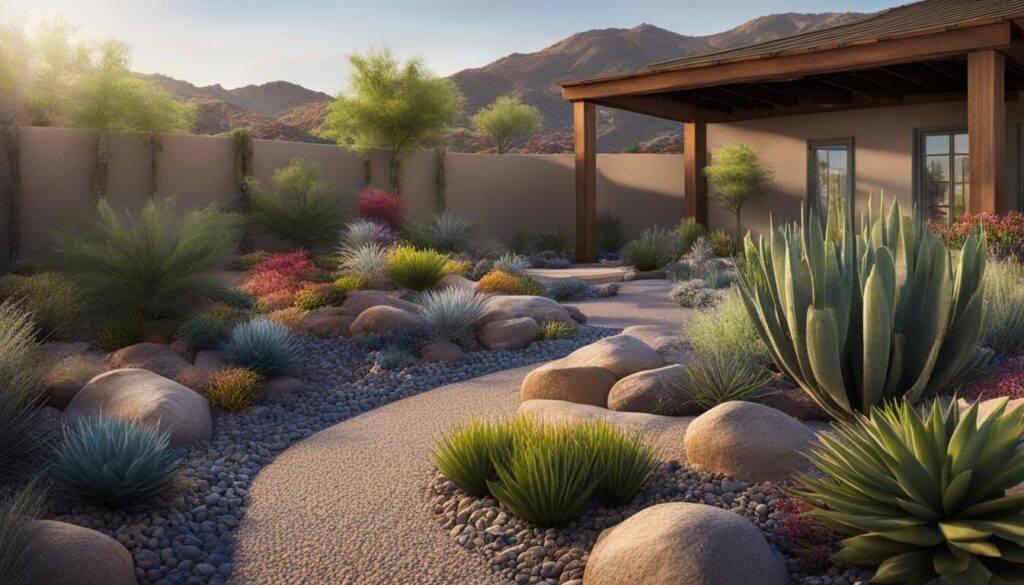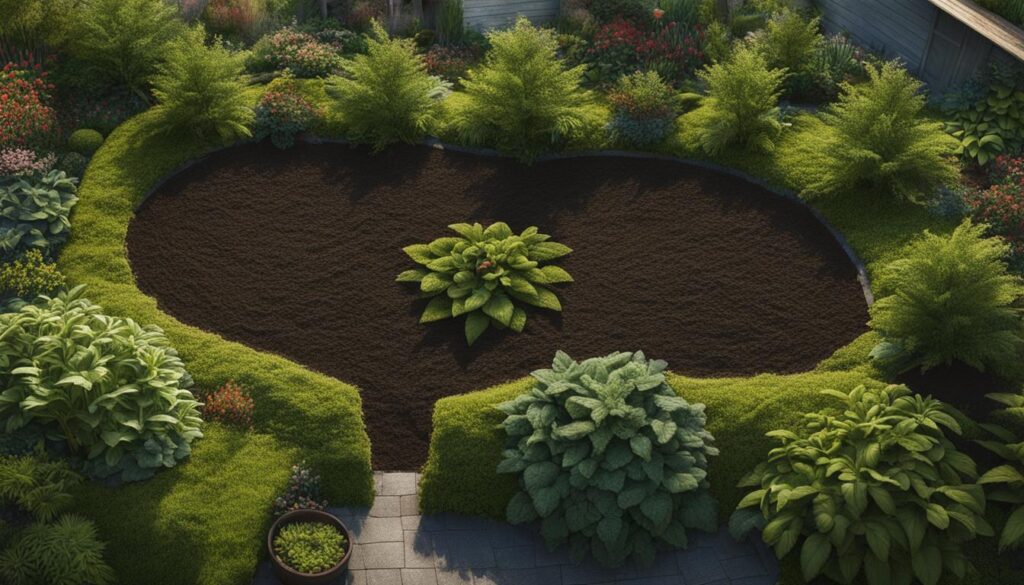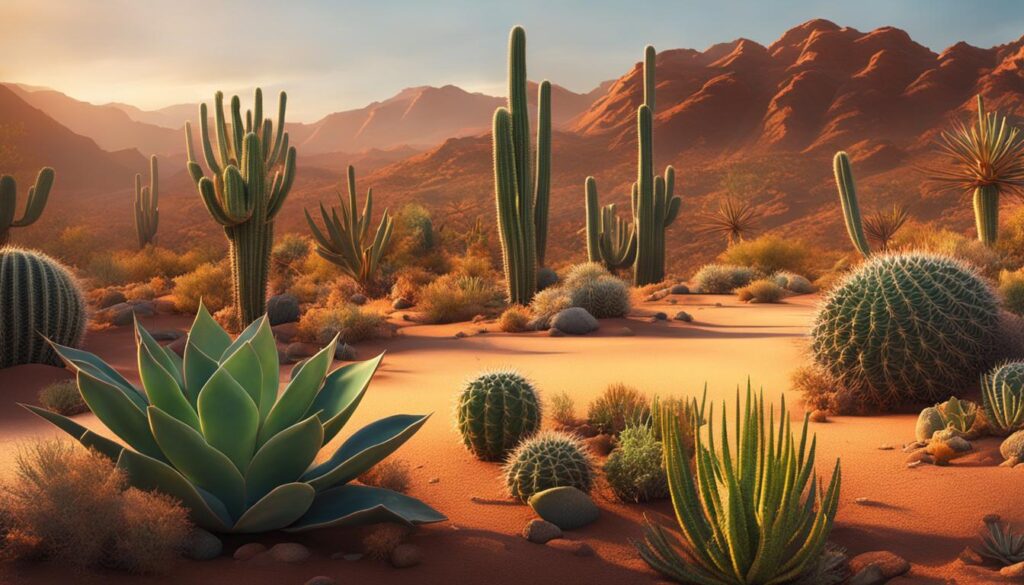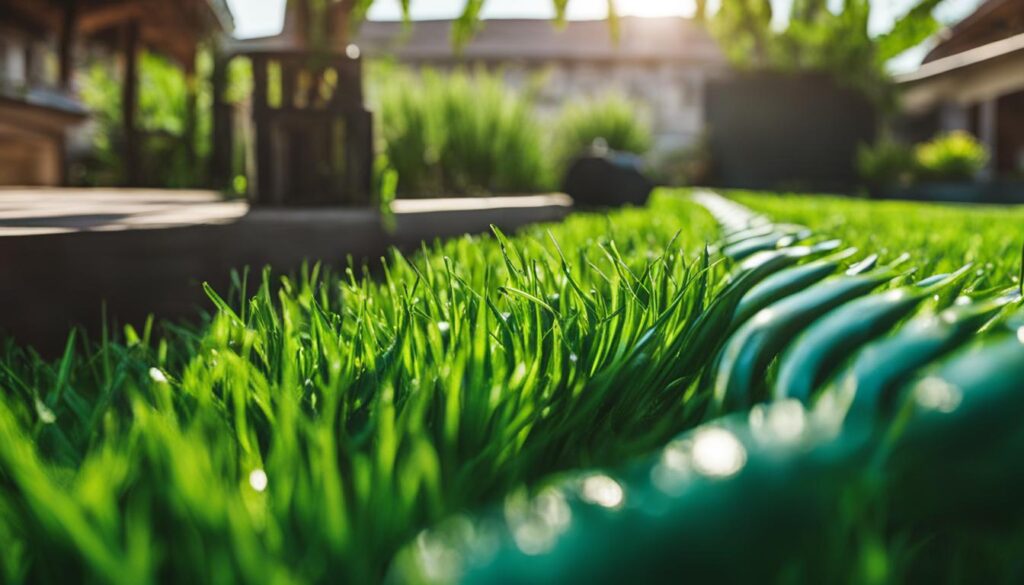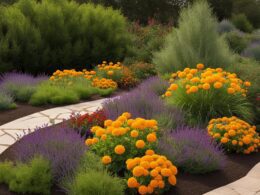Welcome to our guide on xeriscape design, a landscaping style that focuses on conserving water. Whether you’re facing drought conditions or simply want to reduce your water usage, xeriscape design is an effective and sustainable solution. By implementing the principles of xeriscape, you can create a beautiful outdoor space while minimizing water consumption. Let’s explore the key strategies and techniques involved in xeriscape design and how they promote water efficiency.
Key Takeaways:
- Xeriscape design is a landscaping style that conserves water.
- It can be used in any climate and is based on seven principles.
- Planning, soil enhancement, plant selection, and efficient irrigation are key components of xeriscape design.
- Mulching and wise use of turf further contribute to water conservation.
- Implementing xeriscape design can help reduce water bills and contribute to overall water conservation efforts.
Understanding Water Restrictions and the Need for Water Conservation
Water restrictions play a crucial role in managing water resources and promoting water conservation. During periods of drought or when water supplies are limited, local and state authorities often impose restrictions to ensure water is used efficiently and for essential needs. These restrictions are necessary to prioritize drinking water, sanitation, and firefighting over non-essential uses such as landscaping.
In the United States, the average family uses more than 300 gallons of water per day, with a significant portion dedicated to landscaping, reaching around 90 gallons. By understanding and adhering to water restrictions, individuals and communities can make a significant impact in conserving water and minimizing wastage.
Adopting a xeriscape design approach is an effective strategy for water conservation. Xeriscape design focuses on planning and designing landscapes that minimize water usage while still maintaining a beautiful and functional outdoor space. By utilizing drought-resistant plants, efficient irrigation techniques, and proper soil enhancements, xeriscape design helps reduce water consumption and promotes sustainability.
In order to create a visually engaging and informative table, data regarding water usage and potential water savings in different landscape designs can be presented. The table below illustrates the average water consumption for traditional landscaping compared to xeriscape design:
| Landscaping Type | Water Consumption (gallons) |
|---|---|
| Traditional Landscaping | 300+ |
| Xeriscape Design | Significant Reduction |
As seen in the table, xeriscape design can lead to a substantial reduction in water consumption compared to traditional landscaping. By embracing xeriscape principles and understanding the importance of water restrictions, individuals can contribute to water conservation efforts and create sustainable outdoor spaces that flourish even in times of limited water resources.
The Principles of Xeriscape Design
Xeriscape design is built on seven principles that work together to create a water-efficient landscape. These principles include:
- Planning and Designing Landscaping to Conserve Water: Carefully considering the layout of your landscape and choosing water-wise plants can help minimize water usage.
- Enhancing Soil Quality: Adding organic material to the soil improves water retention and promotes healthy root growth.
- Grouping and Using Plants That Conserve Water Together: Plants with similar water needs should be grouped together to optimize irrigation and reduce water waste.
- Irrigating Efficiently: Using methods like drip irrigation and capturing rainwater can ensure that water reaches plant roots effectively without excessive evaporation.
- Using Correct Mulches: Applying mulch to the soil surface helps to retain moisture, suppress weeds, and regulate soil temperature.
- Limiting and Using Turf Wisely: Turf should be used strategically and sparingly, opting for water-efficient grass varieties and placing them in shaded areas to minimize water requirements.
- Making Yard Maintenance a Priority: Regular maintenance, including proper pruning and adjusting irrigation, ensures the long-term sustainability of your xeriscape design.
By following these principles, homeowners can create a landscape that not only conserves water but also enhances the beauty of their outdoor space. Implementing these principles will not only help to minimize water usage but also contribute to sustainable and eco-friendly practices.
| Principle | Description |
|---|---|
| Planning and Designing Landscaping to Conserve Water | Strategically designing the layout of your landscape to optimize water usage and minimize waste. |
| Enhancing Soil Quality | Improving the soil’s ability to retain water through the addition of organic matter. |
| Grouping and Using Plants That Conserve Water Together | Planting water-wise plants in close proximity to optimize irrigation and minimize water usage. |
| Irrigating Efficiently | Using techniques like drip irrigation and rainwater capture to deliver water directly to plant roots. |
| Using Correct Mulches | Applying mulch to the soil surface to retain moisture, control weeds, and regulate soil temperature. |
| Limiting and Using Turf Wisely | Strategically selecting and placing turfgrass, opting for water-efficient varieties, and limiting its use. |
| Making Yard Maintenance a Priority | Regularly maintaining your landscape to ensure the long-term sustainability of your xeriscape design. |
Planning and Designing for Water Conservation
When it comes to creating a water-efficient landscape, careful planning and design are essential. By considering factors such as function, water efficiency, cost, personal preferences, and maintenance, you can craft a landscape plan that not only conserves water but also enhances the beauty of your outdoor space.
One key aspect of planning for water conservation is grouping plants based on their water needs. This allows for efficient irrigation and prevents overwatering or underwatering of certain plants. Additionally, strategically placing trees in your landscape can provide shade, reducing the need for excessive watering and helping other plants conserve water.
It is also important to incorporate native plants or those that are well-suited for the local climate. These plants are adapted to the natural rainfall patterns of the region and require less water to thrive. Furthermore, integrating hardscaping elements, such as pathways or rock features, can limit water usage and add visual interest to your landscape design.
| Planning and Design Tips for Water Conservation |
|---|
| Group plants based on their water needs |
| Strategically place trees for shade |
| Choose native or water-efficient plants |
| Incorporate hardscaping elements |
| Plan irrigation and sprinkler placement |
When planning your irrigation system, consider the layout of your landscape and the water requirements of different plant groups. Plan the placement of irrigation lines and sprinklers to ensure efficient water distribution. Drip irrigation, which delivers water directly to plant roots, is a recommended technique for water conservation in xeriscape design.
By following these planning and design principles, you can create a water-efficient landscape that not only conserves water but also enhances the overall aesthetic appeal of your outdoor space.
Enhancing Soil for Water Retention
Enhancing soil quality is a crucial aspect of xeriscape design as it plays a significant role in water retention. By improving the soil’s ability to hold moisture, you can ensure that plants have access to water when needed, even during periods of drought. Organic material, such as compost, is an excellent addition to enhance soil quality and water retention in your xeriscape design.
Adding compost to the soil increases its organic matter content, creating a spongy and porous texture that allows for better water absorption by plant roots. It also improves soil structure, promoting optimal drainage and preventing water runoff. The increased water retention capabilities of enhanced soil contribute to the overall water efficiency of your xeriscape design.
Benefits of Enhancing Soil for Water Retention
- Improved water absorption by plant roots
- Reduced water runoff
- Optimal soil structure and drainage
- Enhanced water efficiency in xeriscape design
“Enhancing soil quality is key to the success of a xeriscape design. By adding organic material and improving water retention, you create an environment where plants can thrive while minimizing water usage.”
Consulting with local garden shops or experts can provide valuable insights into the specific soil enhancements required for the plants in your xeriscape design. They can guide you in selecting the appropriate compost or other soil amendments based on your region and plant choices. Taking the time to enhance the soil quality in your xeriscape design will ensure the long-term success of your water-efficient landscape.
Choosing Water-Conscious Plants
When it comes to xeriscape design and water conservation, selecting the right plants is crucial. Water-conscious plants, also known as xerophyte plants, are particularly well-suited for landscapes that aim to reduce water usage. These plants have adapted to arid climates and require less water to thrive, making them ideal for xeriscape designs.
Grouping plants together based on their water needs is an effective strategy in xeriscape design. By creating clusters of plants with similar water requirements, you can ensure efficient irrigation and minimize water waste. Additionally, incorporating trees into your xeriscape design can provide shade and help other plants conserve water.
Examples of water-conscious plants for xeriscapes include xerophytes like cacti, Joshua trees, aloe vera, and arctic willows. These plants have evolved to store water in their leaves, stems, or roots, allowing them to survive in dry conditions. Other suitable options include specific trees, shrubs, perennials, and annuals that require less water compared to traditional landscaping plants.
Table: Water-Conscious Plants for Xeriscape Designs
| Plant Type | Water Requirements | Additional Information |
|---|---|---|
| Cacti | Low | Drought-tolerant, store water in their stems |
| Joshua Trees | Low | Native to arid regions and adapted to dry conditions |
| Aloe Vera | Low | Succulent plant with water-storing leaves |
| Arctic Willows | Low | Tolerate cold climates and have efficient water usage |
| Water-Efficient Trees, Shrubs, Perennials, and Annuals | Varies | Choose varieties that thrive in your local climate |
By incorporating water-conscious plants into your xeriscape design, you can create a beautiful and sustainable landscape that conserves water and reduces maintenance needs. These plants not only contribute to water conservation efforts but also add aesthetic value to your outdoor space.
Efficient Irrigation Techniques
Efficient irrigation techniques are crucial in xeriscape design to minimize water waste and ensure optimal plant growth. The two primary methods used in xeriscape design are drip irrigation and rainwater capture. Drip irrigation delivers water directly to the base of plants, reducing evaporation and ensuring that water reaches the roots where it is needed most. This method is highly efficient and can significantly reduce water usage compared to traditional sprinkler systems.
Rainwater capture is another effective technique in xeriscape design. By capturing rainwater from roofs and other surfaces, homeowners can collect and store water for later use in the landscape. This not only reduces the need for additional water sources but also helps prevent stormwater runoff, which can lead to erosion and water pollution. Rainwater capture systems can range from simple rain barrels to more complex underground storage tanks.
In addition to these techniques, it is important to incorporate natural irrigation methods into the design. These methods focus on slowing, spreading, and sinking water into the soil, allowing it to be absorbed by plant roots. This can be achieved through the use of swales, berms, and retention basins, which help retain water on the property and prevent it from flowing away too quickly.
Drip Irrigation and Rainwater Capture in Action
“Implementing drip irrigation and rainwater capture in our xeriscape design has transformed our landscape. Not only have we reduced our water usage significantly, but our plants are thriving. The drip irrigation system ensures that every drop of water is delivered directly to the roots, resulting in healthier, more resilient plants. And by capturing rainwater, we have a free and abundant water source that allows us to maintain our landscape even during droughts. It’s a win-win for both our wallet and the environment!” – John and Lisa, xeriscape enthusiasts
Comparing Drip Irrigation and Traditional Sprinkler Systems
| Method | Water Usage | Water Efficiency | Benefits |
|---|---|---|---|
| Drip Irrigation | Low | High | – Directly delivers water to plant roots – Minimizes evaporation – Reduces water waste |
| Traditional Sprinkler Systems | High | Low | – Water is sprayed over a wide area, leading to evaporation – Uneven distribution of water – Wastes water on non-plant areas |
As the table shows, drip irrigation is far more water-efficient than traditional sprinkler systems. By choosing drip irrigation, you can save significant amounts of water while ensuring that your plants receive the right amount of moisture. This not only benefits your landscape but also contributes to the overall conservation of water resources.
Mulching for Water Conservation
Mulching is a crucial element of xeriscape design that plays an integral role in water conservation. By using organic or inorganic mulch, you can significantly reduce water evaporation, prevent soil erosion, suppress weed growth, and improve overall soil health. Let’s take a closer look at the benefits and differences between organic and inorganic mulch.
Organic Mulch
Organic mulch, such as wood chips, shredded leaves, or straw, not only conserves water but also enriches the soil as it breaks down over time. This type of mulch creates a protective layer on the soil surface, reducing evaporation and keeping the soil cool. Additionally, organic mulch slowly releases nutrients into the soil, promoting healthier plant growth. It acts as a natural barrier against weeds, reducing the need for herbicides and manual weeding.
Inorganic Mulch
In contrast, inorganic mulch includes materials like gravel, rocks, or rubber mulch. While it doesn’t improve soil fertility like organic mulch, it offers its own advantages. Inorganic mulch is long-lasting and provides excellent weed suppression. It allows water to penetrate the soil effectively and reduces erosion, making it a good option for sloped areas. Inorganic mulch also gives a polished and contemporary look to the landscape.
When choosing between organic and inorganic mulch, consider your specific needs and preferences. Organic mulch is ideal for improving soil fertility and creating a natural look, while inorganic mulch offers durability and a low-maintenance option. You can even use a combination of both types to achieve the desired aesthetic and functional benefits.
Remember to apply a layer of mulch, around 2-4 inches thick, around your landscape plants, trees, and in garden beds. This will help conserve water, suppress weeds, and create a visually appealing finish to your xeriscape design. With proper mulching, you can minimize water usage, create a sustainable landscape, and contribute to the overall effort of water conservation.
Wise Use of Turf in Xeriscape Design
When it comes to xeriscape design, incorporating turf can still be a possibility while maintaining water efficiency. By using turf strategically and choosing the right grass types, you can minimize water usage and create an aesthetically pleasing landscape.
Choosing Water-Efficient Turf
Not all grass types are created equal when it comes to water efficiency. Opt for grass varieties with deep roots that are better at retaining moisture. Some water-efficient turf options for xeriscape design include Buffalo, Bermuda, Zoysia, St. Augustine, Blue Fescue, Blue Grama, and California Oatgrass. These grasses require less water compared to other varieties and are well-suited for dry climates.
When incorporating turf into your xeriscape design, it’s essential to limit its use and strategically place it in shaded areas on flat ground. This helps to reduce evaporation and runoff, ensuring that the grass receives sufficient water without wastage. By choosing the right grass types and implementing these techniques, you can maintain an attractive lawn while conserving water.
Avoiding Overwatering
One common mistake with turf is overwatering, which not only wastes water but can also harm the health of the grass. It’s important to determine the appropriate amount of water needed for each cluster of plants and adjust your irrigation system accordingly. By setting timers correctly and regularly monitoring and adjusting irrigation practices, you can ensure that your turf receives the right amount of water without excess.
| Grass Variety | Water Requirements | Suits Climate |
|---|---|---|
| Buffalo | Low | Warm and arid |
| Bermuda | Low to medium | Warm |
| Zoysia | Low to medium | Warm |
| St. Augustine | Medium | Warm |
| Blue Fescue | Low | Cool |
| Blue Grama | Low | Warm and arid |
| California Oatgrass | Low | Warm and arid |
By implementing these techniques and choosing the right grass types, you can ensure that your turf contributes to the overall water efficiency of your xeriscape design. With careful planning and wise use of turf, you can strike a balance between a beautiful lawn and responsible water conservation.
Conclusion
In conclusion, xeriscape design offers an effective and sustainable solution for water-conscious landscaping. By following the seven principles of xeriscape, you can create a beautiful outdoor space that not only conserves water but also reduces water bills. Through careful planning and design, you can optimize your landscape to minimize water usage and maximize water efficiency.
Enhancing soil quality is crucial in xeriscape design as it improves water retention and absorption by plant roots. By adding high-quality organic material to the soil, such as compost, you can create a spongy, drought-resistant soil that holds moisture effectively. This, in turn, reduces the need for excessive watering and contributes to water conservation.
Choosing water-conscious plants is another key aspect of xeriscape design. By selecting plants that are well-suited to your local climate and that conserve water, you can significantly reduce water usage in your landscaping. Grouping plants based on their water needs and incorporating trees that provide shade further enhance water conservation efforts in your xeriscape design.
Efficient irrigation techniques and mulching are essential elements that promote water conservation in xeriscape design. Drip irrigation minimizes evaporation and delivers water directly to plant roots, while mulching helps retain moisture in the soil and prevents water runoff. By using these techniques, you can ensure that water is used efficiently and effectively in your landscape.
By adopting xeriscape design principles and implementing water-conscious landscaping practices, you can create an environmentally-friendly and visually appealing outdoor space. Start your own xeriscape design today and contribute to the overall effort of water conservation.
How Can Xeriscape Design Help in Conserving Water?
Xeriscape design can help conserve water in landscaping. By using drought-tolerant plants, mulch, and efficient irrigation systems, xeriscaping reduces water usage. Landscapers can calculate water savings xeriscaping provides by comparing water usage before and after implementing xeriscape design. This sustainable landscaping approach makes a significant positive impact on water conservation efforts.
FAQ
What is xeriscape design?
Xeriscape design is a landscaping style that focuses on conserving water and is particularly beneficial in areas experiencing drought or water restrictions. It combines planning, efficient irrigation, appropriate plant selection, and other principles to create a water-efficient landscape.
When was xeriscape design coined?
Xeriscape design was coined by the Denver Water Department in 1981.
Can xeriscape design be used in any climate?
Yes, xeriscape design can be used in any climate. It is adaptable to different regions and can be customized to suit local conditions.
How does xeriscape design help conserve water?
Xeriscape design incorporates various techniques such as efficient irrigation, grouping water-conserving plants, mulching, and limiting turf usage, all of which minimize water usage and promote water conservation in landscaping.
What are the principles of xeriscape design?
The principles of xeriscape design include planning and designing landscaping to conserve water, enhancing soil quality, grouping and using plants that conserve water together, irrigating efficiently, using correct mulches, limiting and using turf wisely, and making yard maintenance a priority.
Can xeriscape design help with water restrictions?
Yes, xeriscape design is an effective strategy for water conservation during water restrictions. It helps minimize water usage in landscaping, making it an ideal choice for areas with limited water availability.
How can I plan and design a xeriscape landscape?
When planning and designing a xeriscape landscape, consider factors such as function, water efficiency, cost, personal preferences, and maintenance. Group plants based on their water needs, incorporate shade-providing trees, use native or water-conserving plants, and plan irrigation and sprinkler placement.
Why is enhancing soil quality important in xeriscape design?
Enhancing soil quality improves water retention and allows for better absorption of water by plant roots. It creates a spongy, drought-resistant soil that holds moisture, making it ideal for xeriscape plants.
What types of plants are suitable for xeriscape design?
Suitable plants for xeriscape design are those that conserve water and are well-suited for the local climate. Examples include xerophytes like cacti, Joshua trees, aloe vera, and arctic willows, as well as specific trees, shrubs, perennials, and annuals that require less water.
What is the recommended method of irrigation in xeriscape design?
Drip irrigation is the preferred method of watering in xeriscape design. It minimizes evaporation and delivers water directly to plant roots. Rainwater capture and natural irrigation techniques that slow, spread, and sink water should also be integrated into the design.
How does mulching contribute to water conservation in xeriscape design?
Mulching helps retain moisture in the soil, prevents water runoff, and improves soil health. Organic mulch, such as wood chips, reduces evaporation, minimizes weed growth, and keeps plant roots cool. Inorganic mulch, such as crushed rocks and pebbles, is suitable for larger areas and low-water plants.
Can turf be used in xeriscape design?
Yes, turf can be used in xeriscape design, but it should be limited and placed in shaded areas on flat ground to reduce evaporation and runoff. Choosing grass types with deep roots that are better at retaining moisture is recommended.







